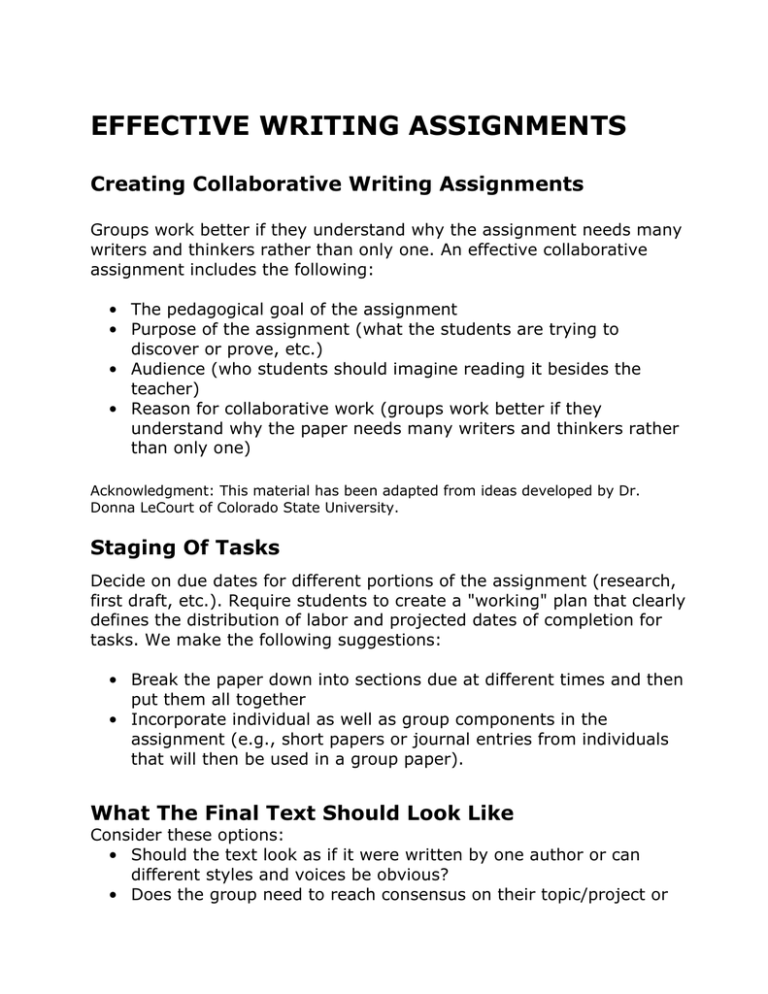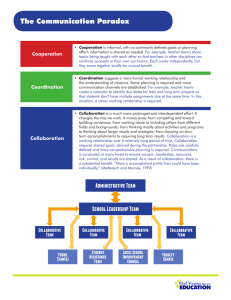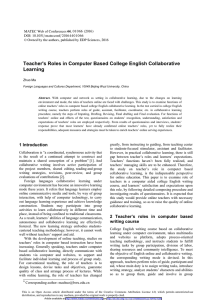EFFECTIVE WRITING ASSIGNMENTS Creating Collaborative Writing Assignments
advertisement

EFFECTIVE WRITING ASSIGNMENTS Creating Collaborative Writing Assignments Groups work better if they understand why the assignment needs many writers and thinkers rather than only one. An effective collaborative assignment includes the following: • The pedagogical goal of the assignment • Purpose of the assignment (what the students are trying to discover or prove, etc.) • Audience (who students should imagine reading it besides the teacher) • Reason for collaborative work (groups work better if they understand why the paper needs many writers and thinkers rather than only one) Acknowledgment: This material has been adapted from ideas developed by Dr. Donna LeCourt of Colorado State University. Staging Of Tasks Decide on due dates for different portions of the assignment (research, first draft, etc.). Require students to create a "working" plan that clearly defines the distribution of labor and projected dates of completion for tasks. We make the following suggestions: • Break the paper down into sections due at different times and then put them all together • Incorporate individual as well as group components in the assignment (e.g., short papers or journal entries from individuals that will then be used in a group paper). What The Final Text Should Look Like Consider these options: • Should the text look as if it were written by one author or can different styles and voices be obvious? • Does the group need to reach consensus on their topic/project or can they include their disagreement (and reasons for it) in the final document? • Can they use headings and sub-headings in the paper? • Are there any other organizational aids they should include? Style Of Collaborative Work Present students with options for ways to work and/or assign a particular approach. Options include: • Groups divide actual writing tasks into units that each student takes responsibility for. • Groups gather to write all of the paper together. • Groups delegate various writing process responsibilities. • Each student drafts the entire paper and group meets to cut and paste sections from each person's draft. Preventative Maintenance Provide a "grievance" procedure for resolving conflicts or have students create one at the onset of collaborative work. Suggest modes of communication for group (e-mail, bulletin boards, shared drafts over the network as well as group meetings). Meeting Times Let students know if they will have class time to work on the paper, and if so, when those days will be; if not, have them devise a meeting schedule for the group. Monitoring Student Progress In addition to working out their topic, have students include information about negotiating the group tasks (e.g., what happens when someone misses a meeting, who is responsible for what parts, a time line for completing certain sections, etc. ). Progress Reports Progress reports from groups can include what has been done, what's left to do, and what plan and schedule the group has for the remaining work. For longer projects, require weekly or bi-weekly status reports via memos or e-mail.



